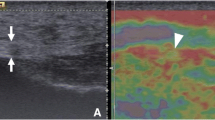Abstract
Purpose
This study assessed the usefulness of upright weight-bearing examination of the ankle/hind foot performed with a dedicated magnetic resonance (MR) imaging scanner in the evaluation of the plantar fascia in healthy volunteers and in patients with clinical evidence of plantar fasciitis.
Materials and methods
Between January and March 2009, 20 patients with clinical evidence of plantar fasciitis (group A) and a similar number of healthy volunteers (group B) underwent MR imaging of the ankle/hind foot in the upright weight-bearing and conventional supine position. A 0.25-Tesla MR scanner (G-Scan, Esaote SpA, Genoa, Italy) was used with a dedicated receiving coil for the ankle/hind foot. Three radiologists, blinded to patients’ history and clinical findings, assessed in consensus morphological and dimensional changes and signal intensity alterations on images acquired in both positions, in different sequences and in different planes.
Results
In group A, MR imaging confirmed the diagnosis in 15/20 cases; in 4/15 cases, a partial tear of the plantar fascia was identified in the upright weight-bearing position alone. In the remaining 5/20 cases in group A and in all cases in group B, the plantar fascia showed no abnormal signal intensity. Because of the increased stretching of the plantar fascia, in all cases in group A and B, thickness in the proximal third was significantly reduced (p<0.0001) under upright weight-bearing compared with the supine position.
Conclusions
Imaging the ankle/hind foot in the upright weight-bearing position with a dedicated MR scanner and a dedicated coil might enable the identification of partial tears of the plantar fascia, which could be overlooked in the supine position.
Riassunto
Obiettivo
Scopo del nostro lavoro è stato dimostrare l’utilità dell’esame sotto carico del retropiede/caviglia eseguito con apparecchiatura di risonanza magnetica (RM) dedicata finalizzato alla valutazione della fascia plantare in volontari sani ed in pazienti con evidenza clinica di fascite plantare.
Materiali e metodi
Nel periodo compreso tra gennaio e marzo 2009, 20 pazienti con diagnosi clinica di fascite plantare (gruppo A) ed altrettanti volontari sani (gruppo B), sono stati sottoposti ad esame RM del retropiede/caviglia sia in ortostatismo che in clinostatismo. Per le indagini è stata utilizzata una apparecchiatura RM dedicata da 0,25 Tesla (G-Scan, Esaote SpA, Genova, Italia) con bobina di ricezione dedicata per retropiede/caviglia. Tre radiologi in consenso e in cieco sull’anamnesi e l’obiettività clinica dei soggetti hanno valutato le alterazioni morfo-dimensionali e dell’intensità di segnale nelle immagini acquisite nelle due posizioni, nelle diverse sequenze e nei differenti piani di scansione.
Risultati
Nel gruppo A, la RM ha confermato la diagnosi in 15/20 casi; in 4/15 casi è stata evidenziata una rottura parziale della fascia plantare visualizzata solo nella posizione ortostatica. Nei restanti 5/20 casi del gruppo A ed in quelli del gruppo B la fascia plantare non presentava alterazioni dell’intensità di segnale. A causa della maggiore tensione della fascia plantare in tutti i casi, gruppo A e B, lo spessore del tratto peri-inserzionale sotto carico si riduceva significativamente (p<0,0001) rispetto al clinostatismo.
Conclusioni
L’imaging del retropiede/caviglia nella posizione ortostatica con RM dedicata e bobina dedicata potrebbe consentire di dimostrare le rotture parziali della fascia plantare che possono rimanere misconosciute in clinostatismo.
Similar content being viewed by others
References/Bibliografia
Grasel RP, Schweitzer ME, Kovalovich AM et al (1999) MR imaging of plantar fasciitis: edema, tears, and occult marrow abnormalities correlated with outcome. AJR Am J Roentgenol 173:699–701
Theodorou DJ, Theodorou SJ, Kakitsubata Y et al (2000) Plantar fasciitis and fascial rupture: MR imaging findings in 26 patients supplemented with anatomic data in cadavers. RadioGraphics 20:S181–S197
Theodorou DJ, Theodorou Sj, Kakitsubata Y et al (2001) Disorders of the plantar aponeurosis: a spectrum of MR imaging findings. AJR Am J Roentgenol176:97–104
Buckup K (2004) Clinical tests for musculoskeletal system. Thieme, New York
Sorrentino F, Iovane A, Vetro A et al (2008) Role of high-resolution ultrasound in guiding treatment of idiopathic plantar fasciitis with minimally invasive techniques. Radiol Med 113:486–495
Tsai WC, Chiu MF, Wang CL et al (2000) Ultrasound evaluation of plantar fasciitis. Scand J Rheumatol 29:255–259
Sabir N, Demirlenk S, Yagci B et al (2005) Clinical utility of sonography in diagnosing plantar fasciitis. J Ultrasound Med 24:1041–1048
Theodorou DJ, Theodorou SJ, Resnick D (2002) MR imaging of abnormalities of the plantar fascia. Semin Musculoskelet Radiol 6:105–118
Roger B, Greiner PH (1997) MRI of plantar fasciitis. Eur Radiol 7:1430–1435
Berkowitz JF, Kier R, Rudicel S (1991) Plantar fasciitis: MR imaging. Radiology 179:665–667
Narvaez JA, Narvaez J, Ortega R et al (2000) Painful heel: MR imaging findings. RadioGraphics 20:333–352
Wearing SC, Smeathers JE, Urry SR et al (2006) The pathomechanics of plantar fasciitis. Sports Med 36:585–611
Yu JS (2000) Pathologic and postoperative conditions of the plantar fascia: review of MR imaging appearance. Skeletal Radiol 29:491–501
Saxena A, Fullem B (2004) Plantar fascia ruptures in athletes. Am J Sports Med 32:662–665
Author information
Authors and Affiliations
Corresponding author
Rights and permissions
About this article
Cite this article
Sutera, R., Iovane, A., Sorrentino, F. et al. Plantar fascia evaluation with a dedicated magnetic resonance scanner in weight-bearing position: our experience in patients with plantar fasciitis and in healthy volunteers. Radiol med 115, 246–260 (2010). https://doi.org/10.1007/s11547-010-0534-z
Received:
Accepted:
Published:
Issue Date:
DOI: https://doi.org/10.1007/s11547-010-0534-z




